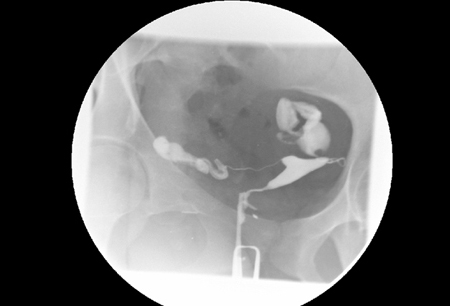Summary
Definition
History and exam
Key diagnostic factors
- presença de fatores de risco
- história de cirurgia pélvica prévia
- ciclos menstruais irregulares
- hirsutismo
- acne
- anomalias uterinas palpáveis
- anomalias anexiais
- galactorreia
Other diagnostic factors
- dispareunia
- anomalias do fundo de saco
Risk factors
- idade >35 anos
- história de infecção sexualmente transmissível
- nível muito alto de gordura corporal
- nível muito baixo de gordura corporal
- tabagismo
- doença autoimune
- história de apendicite
- história de parto cesáreo ou parto vaginal instrumental
- doença psiquiátrica
- uso indevido de substâncias
- consumo de bebidas alcoólicas
- consumo de cafeína
- exposições ocupacionais ou ambientais
- estresse
Diagnostic tests
1st tests to order
- análise de sêmen
- progesterona na fase lútea
- hormônio luteinizante urinário (LH)
- ultrassonografia transvaginal
- teste de anticorpos contra clamídia
- histerossalpingografia
- sono-histerossalpingografia contrastada (Hycosy)
- hormônio folículo-estimulante basal (FSH)
- ultrassonografia com infusão de solução salina
- contagem de folículos antrais
- hormônio antimülleriano (HAM) sérico
Tests to consider
- hormônio luteinizante (LH) sérico
- estradiol sérico
- testosterona sérica livre
- hormônio estimulante da tireoide (TSH) sérico
- teste de doença celíaca
- prolactina sérica
- ultrassonografia 3D
- ressonância nuclear magnética (RNM) pélvica
- laparoscopia e histeroscopia
- cariotipagem
Treatment algorithm
com condição clínica subjacente ou associada
anovulatório
trompa
relacionado a endometriose ou adenomiose
relacionada à idade
útero danificado/ausente
pólipos endometriais ou septo uterino
inexplicada
Contributors
Authors
Andrew Drakeley, MBChB, MD, FRCOG
Consultant Gynaecologist
Hewitt Fertility Centre
Liverpool Women's Hospital
Liverpool
UK
Disclosures
AD is Director and stock holder of IVF 2.0 and Horizon Fertility. AD is an advisor to TMRW Life Sciences and Cambridge Clinical Laboratories, and has received conference attendance support from Ferring, Merck, IBSA, and Theramex Pharma.
Lewis Nancarrow, MD, MRCOG
Subspecialty Trainee in Reproductive Medicine
Hewitt Fertility Centre
Liverpool Women's NHS Foundation Trust
Liverpool
UK
Disclosures
LN has been reimbursed for conference attendances by Ferring and for presenting at a fertility nurses conference by IBSA.
Acknowledgements
Dr Andrew Drakeley and Dr Dr Lewis Nancarrow would like to gratefully acknowledge Dr Daphne Chong, Dr Jane A. Stewart, and Dr Jared C. Robins, previous contributors to this topic.
Disclosures
DC declares that she has no competing interests. JAS is a past Chair of the British Fertility Society; she is also the head of a large NHS fertility service. JCR declares that he has no competing interests.
Peer reviewers
Daniel Williams, MD
Professor of Clinical Obstetrics and Gynecology
University of Cincinnati College of Medicine
Cincinnati
OH
Disclosures
DW declares that he has no competing interests.
Mira Aubuchon, MD
Assistant Clinical Professor
Division of Reproductive Endocrinology
University College of Medicine
Cincinnati
OH
Disclosures
MA declares that she has no competing interests.
Stephanie Dahl, MD
Assistant Clinical Professor
Department of Obstetrics and Gynecology
University of North Dakota School of Medicine
Fargo
ND
Disclosures
SD declares that she has no competing interests.
Peer reviewer acknowledgements
BMJ Best Practice topics are updated on a rolling basis in line with developments in evidence and guidance. The peer reviewers listed here have reviewed the content at least once during the history of the topic.
Disclosures
Peer reviewer affiliations and disclosures pertain to the time of the review.
References
Key articles
National Institute for Health and Care Excellence. Fertility problems: assessment and treatment. Sep 2017 [internet publication].Full text
European Society of Human Reproduction and Embryology. Unexplained infertility: guideline of European Society of Human Reproduction and Embryology. 2023 [internet publication].Full text
Buckett W, Sierra S. The management of unexplained infertility: an evidence-based guideline from the Canadian Fertility and Andrology Society. Reprod Biomed Online. 2019 Oct;39(4):633-40.Full text Abstract
Practice Committee of the American Society for Reproductive Medicine. Evidence-based treatments for couples with unexplained infertility: a guideline. Fertil Steril. 2020 Feb;113(2):305-22.Full text Abstract
Reference articles
A full list of sources referenced in this topic is available to users with access to all of BMJ Best Practice.

Differentials
- Infertilidade do fator masculino
More DifferentialsGuidelines
- Evidence-based diagnosis and treatment for uterine septum: a guideline
- Prevention of moderate and severe ovarian hyperstimulation syndrome: a guideline
More GuidelinesPatient information
Clamídia
Síndrome do ovário policístico: o que é?
More Patient informationLog in or subscribe to access all of BMJ Best Practice
Use of this content is subject to our disclaimer